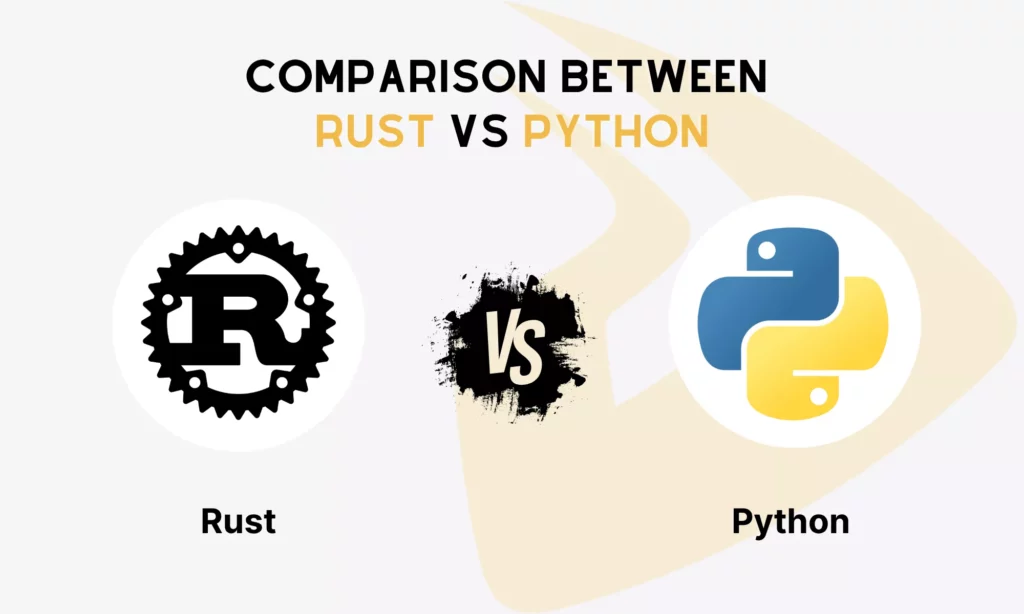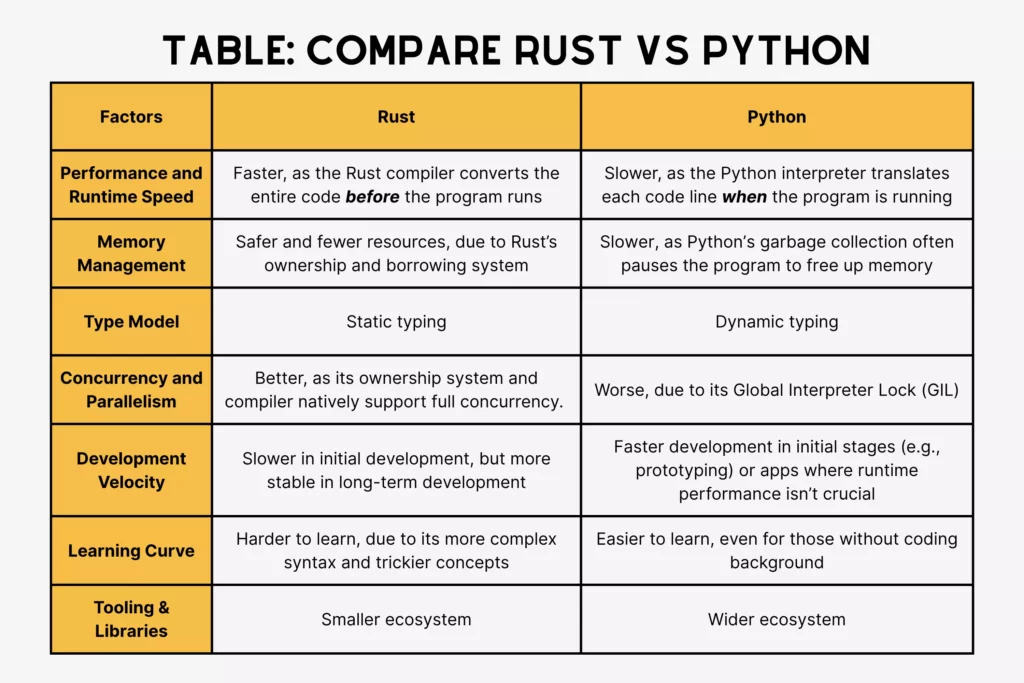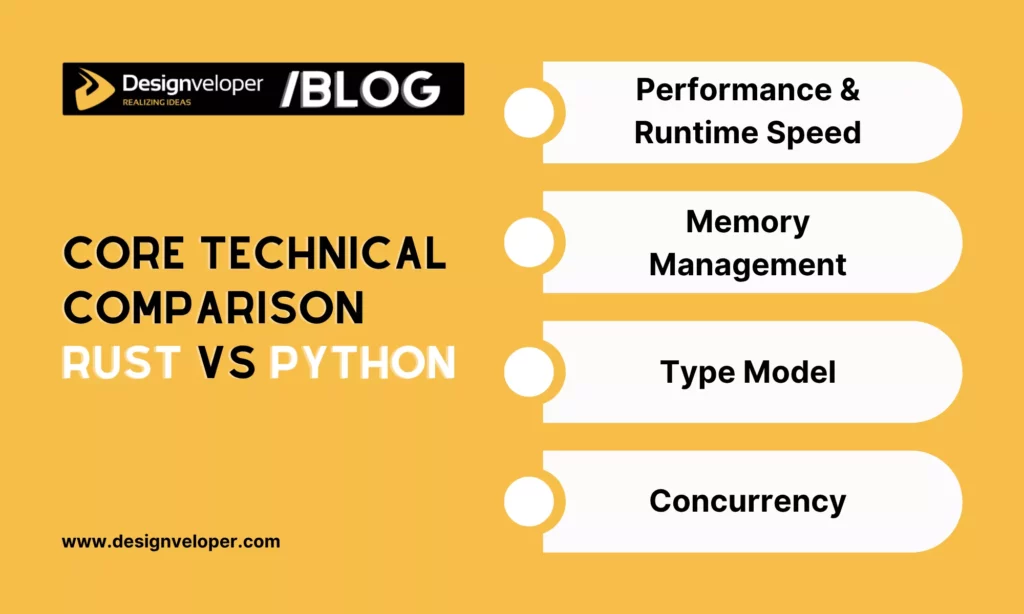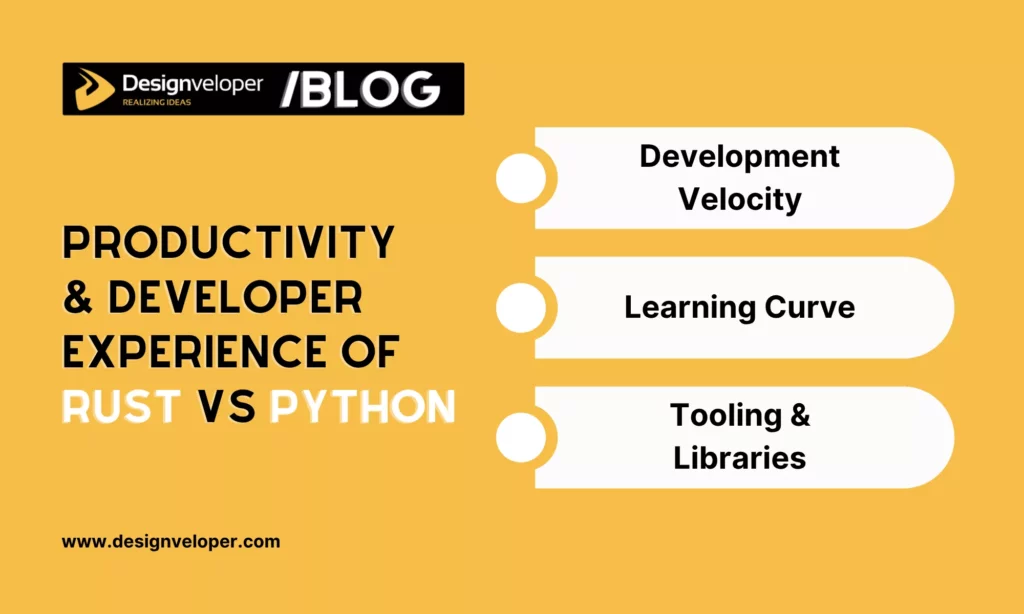Rust and Python are two common programming languages in development projects. Each comes with strengths and weaknesses, making it perfect for different scenarios. Are you hesitating between Rust vs Python? Which one should you adopt for your project?
Well, to answer these two questions, we need to dive deep into the nature and capabilities of these two languages to discover their key differences. Keep reading and learning how they differ!

Understanding Rust and Python: Two Different Philosophies
What are Python and Rust, exactly? Let’s take a quick overview of these two programming languages before diving deep into their key differences:
Quick Overview of Rust
Rust, the statically typed programming language, was developed by Graydon Hoare in 2006.
It’s very young but it’s fast becoming a favorite for developers. This is because it’s memory efficient, works fast and supports multiple tasks at once – what we call “concurrency.”
Rust’s syntax is like C and C++’s, and thus conforms to the coding code of both. But, Rust offers modern features that avoid the common errors that plague C/C++.
One noteworthy about it is memory safety. Rust uses its own ownership model for memory management, eliminating a garbage collector for cleaning unused memory. This also does not only prevent common programming bugs, like data races, but also allows for system-level software to be built more quickly.
Rust also has a friendly compiler and useful abstractions to write high level code that runs as fast as low level code.
Further, the language has built-in tools to generate multi-threaded programs without errors.
Rust also has a strong type system to check for variable and data structure type at compile time. This makes it easier to spot potential bugs early and build more reliable software that will minimize crashes.
Quick Overview of Python
Python is a powerful code language of multiple uses.
Python was developed by Guido van Rossum in 1991. And since then, the language has gained a huge following. In 2025, about 58% of developers use it for their projects.
Why do you think Python is such a popular tech? First, we have to talk about its simplicity and readability.
It’s readable and compatible with many operating systems (Linux, Windows, and macOS). So you can write Python code anywhere without changing.
Also, it’s easily learned and memorized, making it a perfect choice for both experienced developers and beginners.
In addition, it allows you to write code in different programming paradigms, e.g. object-oriented, procedural and functional programming.
But, Python allows dynamic typing. This means you should not have to define the type of data type for the variable. Just code, don’t care much about the type of your data input and the language will automatically adapt when running the program. This allows you to write code faster without the risk of data type limits.
Use Python, and you’ll access a lot of libraries and frameworks. This is why they are popular and common in AI, data science, and backend development (like building high-performance APIs).
Typically, Django and Flask are widely used to create web apps and TensorFlow and PyTorch are for developing deep learning models.
It has a long history of development, with great documentation, and a very supportive community.

Core Technical Comparison Between Rust vs Python

So, how different are Rust and Python? In this section, we’ll compare these two programming languages in technical terms, including performance, memory management, type model, and concurrency.
Performance and Runtime Speed
Generally, Python’s performance is much slower than that of Rust.
When it comes to development speed, we admit that Python is a great choice to build something quickly and easily. However, this is totally different from its runtime speed, which refers to how quickly it runs and completes a task.
Generally speaking, Python is an interpretable language.
That means it uses an interpreter to translate Python code from line-by-line into actions that the machine can understand, at the time the program is running.
This takes Python a lot of work behind the scenes, from checking types to managing memory dynamically.
All this background work costs more time and resources, making Python more slow than compiled languages like Rust.
Meanwhile, Rust has a compiler to convert the code into machine language, which the computer can read directly before the program executes.
To ease it, just think of Python as someone reading and translating the sentences of a foreign language book at the same time. He has to check spelling and grammar while translating. All of this makes translating the entire book slower.
Meanwhile, Rust acts as someone interpreting a whole book before handing you the translated version. This allows you to read it instantly without waiting.
Memory Management and Safety
Rust manages memory with higher safety and fewer resources than Python.
Python relies on garbage collection to automatically look for unused parts of the program and clear the memory. This approach removes the need for manual memory management.
However, its downside is that the garbage collector sometimes pauses the program to free up memory. This makes Python slower, which will become a disadvantage when Python programs have to run very fast or handle large data volumes.
Rust, on the other hand, doesn’t use any garbage collector. Instead, it utilizes its own system of ownership, borrowing, and lifetimes rules to auto-check memory during compilation.
This eliminates the runtime cleanup process, letting Rust programs perform safely and predictably, even during heavy workloads.
Type Model
Python adopts dynamic typing, while Rust uses static typing.
In particular, Python doesn’t require you to define the type of data (e.g., number or text) of each variable. For example:
Pythonx = 10 # x is an integerx = "hello" # now x is a stringThe programming language automatically adapts to data types at runtime, making coding faster and simpler.
However, this dynamic typing feature brings a bit of trouble later. When Python programs are running, the interpreter will constantly check and convert data types, adding overhead and making the programs slower.
Occasionally, Python can read data in the wrong way. For instance, it can consider a number as a string when interpreting the data input.
You can fix this error by using type conversion functions, as in the example below:
Pythonage = int("25") # convert string to integerprice = float("12.5") # convert string to floatMeanwhile, Rust’s static typing requires you to declare what kind of data each variable will hold. For example:
Rustlet x: i32 = 10; // x is an integerlet y: &str = "Hi"; // y is a string sliceIf you change the data type later, Rust will send a compile-time error. Data type checks during compilation may demand a bit of work for developers.
However, it removes the need for type checks at runtime, saves processing time, and enables the compiler to create optimized machine code. Further, this typing approach helps you catch errors before Rust programs run.
Concurrency and Parallelism
Rust works better and faster in concurrency and parallelism than Python.
Python natively features a GIL (Global Interpreter Lock) function that allows one thread to control the interpreter and execute Python code at once.
While you create a multi-threaded program on a multi-core CPU, Python does prevent multiple threads from running on different cores. This makes the program faster but does not also pose challenges to tasks that require high concurrency.
If you want to perform multiple tasks simultaneously in Python, you have to employ other techniques such as multiprocessing or asynchronous programming. Yet these approaches may further add memory and complexity.
Rust, but, supports full concurrency and parallelism because of its ownership structure. This system allows you to write concurrent code and have the compiler check your code during compilation so that you avoid data races.
Rust is fully capable of running multi-core processors, unlike Python. So it can be used for concurrency-related tasks like real-time, high-performance servers or game engines.
Productivity and Developer Experience of Rust vs Python

You now understand the technical differences between Rust vs Python. It’s time to learn about whether these languages are easy to learn and how they help your team create high-quality, efficient code.
Development Velocity
Python has a faster development velocity than Rust, especially in initial development stages (like the prototyping phase) or applications where runtime performance isn’t crucial. However, Rust can win in long-term development.
The syntax is simple, you don’t have to fuss about types, and it’s interpreted, so you just run your code and get quick feedback.
On top of that, there’s a massive pile of libraries and frameworks for almost anything you can think of. You can jump into most editors or IDEs and everything just works — testing, debugging, iterating, you name it.
Honestly, Python’s great when you just need to get something running fast. You can throw together a prototype, test an idea, or build a quick app without too much fuss. That’s where it shines.
However, over time, Python’s typing approach, garbage collection, and GIL lead to runtime issues and slow Python down. This makes Python a limitation in projects that demand high concurrency and performance.
Rust, in contrast, might lose in initial development velocity. Its ownership system, strict compile-time checks, and static typing require more time to write and fix code upfront.
But these traits pay off in the long run. Once development matures, Rust’s design reduces maintenance time, prevents runtime crashes, and improves efficiency, especially for performance-critical or large-scale applications.
Learning Curve
Python is easier to learn than Rust.
Particularly, Python is easier to write and has automatic memory management (“garbage collection”) and a rich library ecosystem. This helps beginners understand programming without having to know coding.
Rust has more complex syntax, static typing, ownership system for memory management, plus a lot. This will require a stronger understanding of system programming and concepts if you want to work well on Rust projects.
Tooling, Ecosystem, and Libraries
Python has a larger ecosystem of libraries, frameworks and tooling than Rust.
That is not surprising as Python was introduced longer than Rust. During this period, the former has many libraries and frameworks for different uses, e.g., Django and Flask for web development, NumPy and Pandas for data science.
Python also has built-in profile and debugging tools such as cProfile’ or pdb’ and uses other technologies such as line_profiler or py-spy to streamline development and increase productivity.
As Rust has more basic ecosystems than Python, the language is less applicable than Python. Its libraries and frameworks are designed for applications, from Actix Web to Rocket to Tokio and Async-std for asynchronous programming.
Rust is also equipped with Cargo, a package manager and a build system. To make Rust development easier, it uses a dependency management tool that automatically compiles your code, runs tests and builds project packages for distribution for Rust.
Pros and Cons When Using Rust vs Python
Python and Rust come with different advantages and disadvantages, making them useful in different scenarios. Now, let’s learn about which pros and cons these languages offer:
| Aspects | Rust | Python |
| Pros | – Rust runs fast. Since it’s compiled and uses zero-cost abstractions, it’s a top pick when you need serious speed. – Rust keeps memory in check with its own ownership and borrowing system. No garbage collector needed, which means fewer bugs and better memory use. – Rust’s built-in ownership system helps you write concurrent code and avoid data races. |
– Python keeps things simple. Its syntax is clean and easy to read. So even if you’ve never coded before, you can jump right in. – There’s a massive library ecosystem in Python. Whether you’re into web development, crunching data, or machine learning, Python’s got you covered. It also plays well with all sorts of databases and external tools, making your workflow smoother and speeding up development. – Python’s documentation, tutorials, and community are all there to help you. – Dynamic typing lets you write code fast without getting bogged down in type rules. |
| Cons | – Requires developers to know system-level programming concepts and strict compile-time rules. So, Rust is not for beginners who have no coding knowledge. – Has a smaller ecosystem due to its younger age. – Slows down initial development stages, typically prototyping. |
– Performs slowly due to Python’s interpreted nature, making it unsuitable for computing -heavy tasks. – Struggle to handle multiple tasks at once due to its built-in GIL (Global Interpreter Lock). |
Rust vs Python for Specific Use Cases
Given the different features, strengths, and weaknesses, you may wonder when to use which. Below are specific use cases where Rust and Python shine:
Rust’s low-level hardware access, memory safety, and compliance with C/C++ coding standards make it highly applicable in building:
- Operating systems and device drivers
- Web backends and network applications.
- Embedded systems, like IoT apps and microcontrollers
- Command-line (CLI) tools across platforms.
- Game engines and graphics-intensive apps
- High-performing computing tasks, like data processing, scientific computing, and simulations.
- Blockchain and cryptography projects
- Cloud infrastructure
Meanwhile, Python’s syntax readability, diverse ecosystem (Django, Scikit-learn, SymPy, etc.), and integrations with hardware allow you to create:
- Web applications
- Data analysis and visualization
- AI/ML models and applications
- Scientific research, complex computing tasks, and simulations
- Automation scripts to automate repetitive tasks (e.g., file manipulation or system administration)
- Multimedia apps and games
- Cross-platform desktop apps
- Communication protocols and networks
- Security tools and malware analyzers.
Making the Choice: Which Language is Best for Your Project?

Trying to pick between Rust and Python for your project? It really comes down to what you need. Think about what matters most for your project—speed, memory use, safety, or maybe just getting things done quickly.
If you know both languages, line them up against your checklist. What does your project actually need?
If you care most about memory efficiency, handling lots of tasks at once, rock-solid safety, or top-notch performance, Rust’s the one you want. Some popular cases include systems programming, game engine development, and embedded system building.
By contrast, Python works best for quickly developing web apps, building AI/ML models, and performing exploratory data analysis.
Can Rust and Python Work Together?
Besides using Rust and Python separately, you can combine these two languages in a single project to get the most value from them.
This integration proves useful if your team requires Python for the overall app structure and high-level logic, while demanding performance-critical components (e.g., data processing, simulation, or cryptography) that should be built in Rust.
There are many ways to use the power of these languages to the fullest.
- First, use PyO3. This package lets you write native Python modules in Rust or embed Python inside a Rust binary. PyO3 is ideal if you want to speed up specific Python functions that perform too slowly.
- Second, compile the Rust code as a native C-compatible extension and load it in Python by using `ctypes` or `cffi`.
- Third, leverage `maturin` to automate creating and distributing Rust code as Python packages. Many performance-critical Python libraries (like Polars) use this approach to build their core engines in Rust for data processing and analytics.
- Last but not least, run Rust as a standalone microservice and call it from Python. This approach is widely adopted in production systems.
However, combining Rust and Python is often complex and requires developers to have foundational Rust knowledge to fix integration issues.
Will Rust Replace Python?
The answer is no.
Each programming language has different strengths and serves different purposes. Instead of saying what will replace what, we should pay more attention to when the best use case is to leverage these two languages.
Python focuses on simplicity and productivity. Its diverse ecosystem of libraries, frameworks, and tools makes it versatile in many scenarios, from web development to data analysis and machine learning models.
Meanwhile, Rust shines in areas where Python struggles. Its focus on performance, memory efficiency, and concurrency makes Rust perfect for programming systems, building game engines & real-time apps, and performing computation-intensive tasks.
Therefore, you can say Rust complements Python in performance-critical components and helps Python overcome its weaknesses rather than being a complete substitute for Python.
FAQs about Rust vs Python
Is Rust faster than Python?
Yes, Rust performs faster than Python due to its compiled nature.
As we already explained, Rust uses the compiler to convert the entire code into machine language before the program runs. This allows the computer to execute Rust code straight away.
Meanwhile, the Python interpreter translates and executes each code line at runtime. This makes Python slower.
Is Rust harder to learn than Python?
It depends on what you already know.
If you’re a beginner and know nothing about coding, learning Rust is definitely harder than Python.
This is just because Python’s simpler and readable syntax structure hides the complex parts of programming, enabling you to focus on problem-solving. This helps even novices learn about Python more easily.
Meanwhile, Rust requires learners to understand its memory management, ownership rules, and other concepts. Without a profound knowledge of such stuff, you may struggle to learn Rust in comparison with Python.
However, if you have already learned C/C++ whose low-level concepts (e.g., memory management or concurrency) and syntax are similar to Rust, this language might be as easy to learn as Python.
Should I learn Rust or Python first?
The answer depends on various factors. Ask yourself what your main goal of learning is and what kind of developer you want to become.
If you’re curious about technologies and want to find something easy to enter the field, then start with Python. You can focus on learning programming logic instead of worrying about technically complex ideas about memory or something.
Python also has wide applications, a massive ecosystem, and a supportive community, so you can find help easily and apply what you learned in various cases.
If you’re comfortable with some programming concepts and want to build something sophisticated, like embedded systems or graphics-heavy apps, try Rust.
Initiating Rust/Python Projects with Designveloper
Are you looking for the best Rust or Python developers for your project? Here at Designveloper – the leading software development company in Vietnam, we have highly skilled developers in these languages.
Our professional team has deep technical expertise, plus long years of experience in implementing over 200+ projects. We skillfully combine the right libraries and tools with Python and Rust to build high-quality, scalable solutions for our clients across domains, whether e-commerce, finance, or healthcare.
Beyond common technologies, we integrate AI capabilities using tooling, like OpenAI or LangChain, to streamline business functions and improve productivity. We also adopt flexible Agile frameworks (SCRUM, Kanban) to develop digital products with the most critical components. This ensures on-time delivery and keeps our work within your estimated budget.
Wanna see our successful portfolio further in Python or Rust? Contact us and let us turn your paper idea into a working solution!


